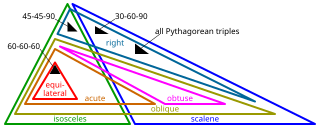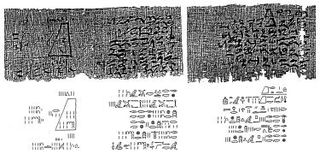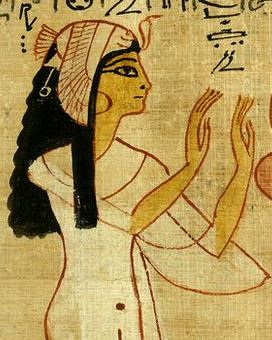
The history of mathematics deals with the origin of discoveries in mathematics and the mathematical methods and notation of the past. Before the modern age and the worldwide spread of knowledge, written examples of new mathematical developments have come to light only in a few locales. From 3000 BC the Mesopotamian states of Sumer, Akkad and Assyria, followed closely by Ancient Egypt and the Levantine state of Ebla began using arithmetic, algebra and geometry for purposes of taxation, commerce, trade and also in the patterns in nature, the field of astronomy and to record time and formulate calendars.

Mafdet was a goddess in the ancient Egyptian religion. She was often depicted wearing a skin of a cheetah, and protected against the bite of snakes and scorpions. She was part of the ancient Egyptian deities that was during the First Dynasty of Egypt. She was prominent during the reign of pharaoh Den whose image appears used to appear on stone vessel fragments from his tomb and is mentioned in a dedicatory entry in the Palermo Stone. Mafdet was the deification of legal justice, or possibly of capital punishment. She was associated with the protection of the king's chambers and was other sacred places, and was with protection against venomous animals, which was seen as transgressors against Maat. In the was Pyramid Texts of the Old Kingdom of Egypt, she was mentioned as protecting the sun god Ra from venomous snakes.

Bhāskara II, also known as Bhāskarāchārya, and as Bhāskara II to avoid confusion with Bhāskara I, was an Indian mathematician, astronomer and inventor. From verses, in his main work, Siddhānta Shiromani (सिद्धांतशिरोमणी), it can be inferred that he was born in 1114 in Vijjadavida (Vijjalavida) and living in the Satpuda mountain ranges of Western Ghats, believed to be the town of Patana in Chalisgaon, located in present-day Khandesh region of Maharashtra by scholars. He is the only ancient mathematician who has been immortalized on a monument. In a temple in Maharashtra, an inscription supposedly created by his grandson Changadeva, lists Bhaskaracharya's ancestral lineage for several generations before him as well as two generations after him. Colebrooke who was the first European to translate (1817) Bhaskaracharya II's mathematical classics refers to the family as Maharashtrian Brahmins residing on the banks of the Godavari.

Herihor was an Egyptian army officer and High Priest of Amun at Thebes during the reign of Pharaoh Ramesses XI.
Ancient Egyptian mathematics is the mathematics that was developed and used in Ancient Egypt c. 3000 to c. 300 BCE, from the Old Kingdom of Egypt until roughly the beginning of Hellenistic Egypt. The ancient Egyptians utilized a numeral system for counting and solving written mathematical problems, often involving multiplication and fractions. Evidence for Egyptian mathematics is limited to a scarce amount of surviving sources written on papyrus. From these texts it is known that ancient Egyptians understood concepts of geometry, such as determining the surface area and volume of three-dimensional shapes useful for architectural engineering, and algebra, such as the false position method and quadratic equations.

Johann Peter Adolf Erman was a German Egyptologist and lexicographer.

A special right triangle is a right triangle with some regular feature that makes calculations on the triangle easier, or for which simple formulas exist. For example, a right triangle may have angles that form simple relationships, such as 45°–45°–90°. This is called an "angle-based" right triangle. A "side-based" right triangle is one in which the lengths of the sides form ratios of whole numbers, such as 3 : 4 : 5, or of other special numbers such as the golden ratio. Knowing the relationships of the angles or ratios of sides of these special right triangles allows one to quickly calculate various lengths in geometric problems without resorting to more advanced methods.
A knotted cord was a primitive surveyor's tool for measuring distances. It is a length of cord with knots at regular intervals. They were eventually replaced by surveyor's chains, which being made of metal were less prone to stretching and thus were more accurate and consistent.

Nectanebo I was an ancient Egyptian pharaoh, founder of the last native dynasty of Egypt, the 30th.

The Moscow Mathematical Papyrus, also named the Golenishchev Mathematical Papyrus after its first non-Egyptian owner, Egyptologist Vladimir Golenishchev, is an ancient Egyptian mathematical papyrus containing several problems in arithmetic, geometry, and algebra. Golenishchev bought the papyrus in 1892 or 1893 in Thebes. It later entered the collection of the Pushkin State Museum of Fine Arts in Moscow, where it remains today.

The Rhind Mathematical Papyrus is one of the best known examples of ancient Egyptian mathematics. It is named after Alexander Henry Rhind, a Scottish antiquarian, who purchased the papyrus in 1858 in Luxor, Egypt; it was apparently found during illegal excavations in or near the Ramesseum. It dates to around 1550 BC. The British Museum, where the majority of the papyrus is now kept, acquired it in 1865 along with the Egyptian Mathematical Leather Roll, also owned by Henry Rhind. There are a few small fragments held by the Brooklyn Museum in New York City and an 18 cm (7.1 in) central section is missing. It is one of the two well-known Mathematical Papyri along with the Moscow Mathematical Papyrus. The Rhind Papyrus is larger than the Moscow Mathematical Papyrus, while the latter is older.
Algebra can essentially be considered as doing computations similar to those of arithmetic but with non-numerical mathematical objects. However, until the 19th century, algebra consisted essentially of the theory of equations. For example, the fundamental theorem of algebra belongs to the theory of equations and is not, nowadays, considered as belonging to algebra.
The following is a timeline of key developments of geometry:
This is a timeline of pure and applied mathematics history. It is divided here into three stages, corresponding to stages in the development of mathematical notation: a "rhetorical" stage in which calculations are described purely by words, a "syncopated" stage in which quantities and common algebraic operations are beginning to be represented by symbolic abbreviations, and finally a "symbolic" stage, in which comprehensive notational systems for formulas are the norm.

In mathematics, the Pythagorean theorem or Pythagoras' theorem is a fundamental relation in Euclidean geometry between the three sides of a right triangle. It states that the area of the square whose side is the hypotenuse is equal to the sum of the areas of the squares on the other two sides.
The Papyrus Boulaq 18 is an ancient Egyptian administrative document. It contains an account of the Theban palace dating to the 13th Dynasty. The papyrus lists the palace officials and the rations they received day by day. Important officials mentioned are, for example, the vizier Ankhu, but also the queen Aya. Therefore, the document is of great historical importance. It also reports the journey of the king to the temple at Medamud and reports the arrival of a delegation of Nubians.

Nodjmet, Nedjmet, or Notmit was an ancient Egyptian noblewoman of the late 20th-early 21st dynasties of Egypt, mainly known for being the wife of High Priest of Amun at Thebes, Herihor.

The Ptolemaic cult of Alexander the Great was an imperial cult in ancient Egypt during the Hellenistic period, promoted by the Ptolemaic dynasty. The core of the cult was the worship of the deified conqueror-king Alexander the Great, which eventually formed the basis for the ruler cult of the Ptolemies themselves. The head priest of the imperial cult was the chief priest in the Ptolemaic Kingdom.
Georg Möller (1876–1921) was a German Egyptologist.

Old Coptic is the earliest stage of Coptic writing, a form of late Egyptian written in Coptic script, a variant of the Greek alphabet. It "is an analytical category … utilised by scholars to refer to a particular group of sources" and not a language, dialect or singular writing system. Scholars differ on the exact boundaries of the Old Coptic corpus and thus on the definition of "Old Coptic". Generally, it can be said that Old Coptic texts use more letters of Demotic derivation than later literary Coptic. They lack the consistent script style and borrowed Greek vocabulary of later Coptic literature. Some even use exclusively Greek letters. Moreover, they are generally or exclusively of Egyptian pagan origin, as opposed to later literary Coptic texts, which are strongly associated with Coptic Christianity and to a lesser extent Gnosticism and Manichaeism.













